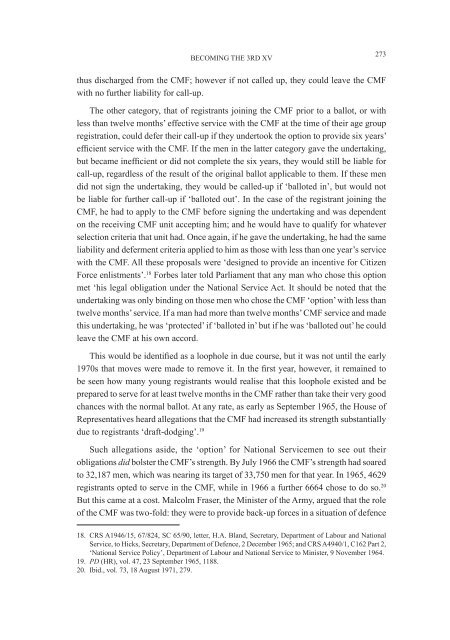conference proceedings - Australian Army
conference proceedings - Australian Army
conference proceedings - Australian Army
You also want an ePaper? Increase the reach of your titles
YUMPU automatically turns print PDFs into web optimized ePapers that Google loves.
BECOMING THE 3RD XV<br />
thus discharged from the CMF; however if not called up, they could leave the CMF<br />
with no further liability for call-up.<br />
The other category, that of registrants joining the CMF prior to a ballot, or with<br />
less than twelve months’ effective service with the CMF at the time of their age group<br />
registration, could defer their call-up if they undertook the option to provide six years’<br />
efficient service with the CMF. If the men in the latter category gave the undertaking,<br />
but became inefficient or did not complete the six years, they would still be liable for<br />
call-up, regardless of the result of the original ballot applicable to them. If these men<br />
did not sign the undertaking, they would be called-up if ‘balloted in’, but would not<br />
be liable for further call-up if ‘balloted out’. In the case of the registrant joining the<br />
CMF, he had to apply to the CMF before signing the undertaking and was dependent<br />
on the receiving CMF unit accepting him; and he would have to qualify for whatever<br />
selection criteria that unit had. Once again, if he gave the undertaking, he had the same<br />
liability and deferment criteria applied to him as those with less than one year’s service<br />
with the CMF. All these proposals were ‘designed to provide an incentive for Citizen<br />
Force enlistments’. 18 Forbes later told Parliament that any man who chose this option<br />
met ‘his legal obligation under the National Service Act. It should be noted that the<br />
undertaking was only binding on those men who chose the CMF ‘option’ with less than<br />
twelve months’ service. If a man had more than twelve months’ CMF service and made<br />
this undertaking, he was ‘protected’ if ‘balloted in’ but if he was ‘balloted out’ he could<br />
leave the CMF at his own accord.<br />
This would be identified as a loophole in due course, but it was not until the early<br />
1970s that moves were made to remove it. In the first year, however, it remained to<br />
be seen how many young registrants would realise that this loophole existed and be<br />
prepared to serve for at least twelve months in the CMF rather than take their very good<br />
chances with the normal ballot. At any rate, as early as September 1965, the House of<br />
Representatives heard allegations that the CMF had increased its strength substantially<br />
due to registrants ‘draft-dodging’. 19<br />
Such allegations aside, the ‘option’ for National Servicemen to see out their<br />
obligations did bolster the CMF’s strength. By July 1966 the CMF’s strength had soared<br />
to 32,187 men, which was nearing its target of 33,750 men for that year. In 1965, 4629<br />
registrants opted to serve in the CMF, while in 1966 a further 6664 chose to do so. 20<br />
But this came at a cost. Malcolm Fraser, the Minister of the <strong>Army</strong>, argued that the role<br />
of the CMF was two-fold: they were to provide back-up forces in a situation of defence<br />
18. CRS A1946/15, 67/824, SC 65/90, letter, H.A. Bland, Secretary, Department of Labour and National<br />
Service, to Hicks, Secretary, Department of Defence, 2 December 1965; and CRS A4940/1, C162 Part 2,<br />
‘National Service Policy’, Department of Labour and National Service to Minister, 9 November 1964.<br />
19. PD (HR), vol. 47, 23 September 1965, 1188.<br />
20. Ibid., vol. 73, 18 August 1971, 279.<br />
273

















